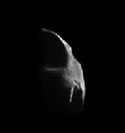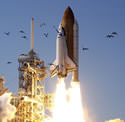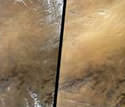Scientists believe there may be chlorophyll, a substance used by plants to extract energy from sunlight, located near the landing site for the 1997 Mars Pathfinder mission. Scientists analyzed the spectral signature of the area surrounding Pathfinder’s landing site. Although the researchers have stressed that their findings are preliminary, they believe they’ve found two areas that appear to contain chlorophyll – it could be significant, or it just could be a patch of coloured soil.
Hubble Gets Back to Work
After three weeks of tests, NASA controllers have given the newly upgraded Hubble Space Telescope a clean bill of health. Initial tests are largely complete; however, calibrations of the observatory’s instruments are expected to continue for another two months. Routine science observations have now resumed using the telescope’s Imaging Spectrograph and the Wide Field and Planetary Camera 2.
After three weeks of in-orbit checkout, following its deployment from Space Shuttle Columbia on March 9, the Hubble Space Telescope has been declared healthy and fit by engineers and scientists at NASA’s Goddard Space Flight Center in Greenbelt, Md., and the Space Telescope Science Institute in Baltimore.
Initial checkout of the spacecraft and instruments has largely been completed. However, the calibration process for the instruments will continue for another two months. The new rigid solar arrays, coupled with the new Power Control Unit, are working perfectly, generating 27 percent more electrical power than the old arrays. This increase in power roughly doubles the power available to the scientific instruments. The new reaction wheel is operating normally.
The powerful new Advanced Camera for Surveys (ACS) is now undergoing its final optical alignment and focus checks. The image quality of individual stars observed in a standard calibration field is excellent. The Advanced Camera’s light-sensing detectors are also working very well. It is anticipated that the first Early Release Observations of astronomical targets taken with the Advanced Camera for Surveys will be available around the first week in May.
The new, high-tech mechanical cooler inserted by the Astronauts during SM3B has been working continuously and properly since March 18. The cooler?s intended purpose is to attempt to resuscitate the dormant Near-Infrared Camera and Multi-Object Spectrometer (NICMOS), which depleted its expendable solid nitrogen coolant in January 1999. Although this new ?refrigerator?, dubbed the NICMOS Cooling System (NCS), has been reliably generating the amount of cooling power expected, Hubble engineers report that the NICMOS instrument is cooling down more slowly than originally expected. Because it will take longer to reach the proper operating temperature, below approximately 80 degrees Kelvin, the initial checkout and scientific observations with NICMOS will be delayed for several weeks.
Routine science observations have now resumed with the Space Telescope Imaging Spectrograph and the Wide Field and Planetary Camera 2, the two instruments that were operating on Hubble prior to Servicing Mission 3B. On another note, a gyro (Gyro 3) that had not been performing as well as it should prior to the mission resumed perfect operation after it was turned off and re-started while Hubble was in Columbia’s payload bay.
The Space Shuttle Columbia journeyed to the Hubble Space Telescope for the fourth servicing mission on March 1, 2002. During a series of five spacewalks, Astronauts installed new hardware and upgraded older systems, leaving the telescope better than ever. After a successful mission spanning 11 days in orbit, the shuttle landed safely on March 12 at Kennedy Space Center, Fla.
Original Source: NASA News Release
Asteroids Could Be Double Previous Estimates
Asteroids in our solar system could be more numerous than previously thought according to a new survey done using the European Space Agency’s Infrared Space Observatory (ISO). The ISO’s survey indicates that there are between 1.1 million and 1.9 million asteroids larger than 1km in the main asteroid belt, located between Mars and Jupiter. This result is roughly double the number of asteroids estimated by previous surveys using other observatories.
New Strategy for Deflecting Smaller Asteroids

Image credit: NASA
A planetary scientist from the University of Arizona believes that smaller asteroids could be moved out of collision paths with the Earth by changing how much sunlight they reflect. Given many years of lead time (decades or even centuries), a smaller asteroid could be covered in dirt, painted white, or covered with a solar collector. This would change the amount of heat the asteroid radiates into space, and cause its orbit to drift away from a killer trajectory.
Humans could deflect small but dangerous asteroids from Earth by changing how much sunlight the asteroids reflect, a University of Arizona planetary scientist suggests in the current issue (April 5) of Science.
Possible schemes might include covering the upper few centimeters of the asteroid with dirt, or painting its surface white, or fusing part of its surface with a spaceborne solar collector ? all technically feasible and civically preferable to launching a nuclear warhead to blast an incoming asteroid off course.
Changing how much heat a space rock radiates will change how it drifts in its orbit because of the Yarkovsky effect, said Joseph N. Spitale of the UA Lunar and Planetary Laboratory in his article, “Asteroid Hazard Mitigation Using the Yarkovsky Effect.”
The Yarkovsky effect is a long-known but long-obscure phenomenon named for the Polish engineer who first described it around 1900. The effect is caused because when an unevenly heated body re-radiates heat, hotter spots are subjected to a stronger recoil force than are cooler spots. As I.O. Yarkovsky noted, the differences in momentum nudge the object so that it drifts slightly in its orbit, Spitale said. The effect is a relatively small force, but it accumulates through time.
Not until the mid-1990s did planetary scientists begin to realize how important the Yarkovsky effect is in calculating motions of asteroid fragments in the belt between Mars and Jupiter. These include Cornell University’s William F. Bottke Jr., David P. Rubincam of NASA Goddard Space Flight Center, Paolo Farinella of the University of Pisa in Italy, David Vokrouhlicky of Charles University in the Czech Republic, and William Hartmann of the Planetary Science Institute in Tucson.
The mechanism explains why more asteroid fragments than otherwise can be predicted are launched from the main asteroid belt toward Earth, hitting as meteorites, according to their papers. And it explains how space rocks can drift for millions of years before arriving at main belt asteroid “resonance” zones from which they’re flung to the inner solar system, they conclude.
“It’s pretty clear that this is an important effect when it comes to getting material from the asteroid belt to the inner planets,” Spitale said in an interview.
He’s working to develop a sophisticated thermal model to use to precisely calculate Yarkovsky drift for specific asteroids. Asteroid shape, spin, composition and surface details all must be factored in to get a precise orbit for a specific asteroid.
In his Science article, Spitale describes his calculations of Yarkovsky drift for three stony near-Earth asteroids, 6489 Golevka (300 meters diameter), 1566 Icarus (one kilometer diameter) and 1620 Geographos (2.5 kilometers diameter).
The idea then is to change a threatening asteroid’s surface temperatures so that, over decades or centuries, its orbit veers away from Earth.
“You might take one of the smaller bare-rock bodies and put a lot of dirt on it, for a dramatic change in thermal conductivity,” Spitale said. “Blanketing the asteroid with a centimeter of dirt is technically feasible, but it would be expensive.
“Another way you could do it would be to paint it. If you could cover the surface with a millimeter of white material, you could ‘turn off’ the Yarkovsky effect altogether. That could produce a fairly big change in where the body would be in another century or so.
“This would be effective in another approach, suggested by Jay Melosh (UA professor of planetary sciences). It is to use a solar collector – basically just a big dish that focuses sunlight on a body ? to fuse a region of the surface and blast off mass, so the object changes course because of its different mass. But in the process of this, you’d also change the thermal conductivity of the asteroid, giving it a new orbit also because of the Yarkovsky effect.”
Spitale said the proposed technique would be useless for a large asteroid or an asteroid less than decades away from Earth..
“This technique will work best on objects the size of Golevka or smaller (300 meters, about 1,000 feet, or smaller). An object that size could do damage to the better part of a country. Even a 100-meter or 50-meter object can take out a good part of a city.”
“The biggest technical problem right now with this approach is just doing the calculations to understand how we’d actually be affecting the orbit by doing something to an asteroid surface,” Spitale said.
If the orbit is miscalculated, an object on course to deliver Earth a glancing blow may be “mitigated” into an object on course to deliver a direct hit.
The flip side of that is, you need a good model to compute Yarkovsky effect perturbations even to know which asteroids pose real hazards, Spitale added. “That may be the most important use of all for this model, to predict which are going to hit in the first place,” he said.
Original Source: UA News Release
Atlantis Blasts Off

Image credit: NASA
The space shuttle Atlantis lifted off from Cape Canaveral this morning, carrying seven astronauts and headed for the International Space Station. Liftoff occurred at 2044 GMT (4:44pm EDT), four days late because of a leaky fuel line on the shuttle’s launch pad. The shuttle is expected to dock with the station on Wednesday, and astronauts will begin the first of four spacewalks to install a new truss that will serve as a backbone for the station.
With the International Space Station and the Expedition Four crew orbiting high overhead, the shuttle Atlantis lifted off this afternoon on a complex mission to install a 43-foot long truss structure as the backbone for future expansion of the orbital outpost.
Commander Mike Bloomfield, Pilot Steve Frick, Flight Engineer Ellen Ochoa and spacewalkers Steve Smith, Rex Walheim, Jerry Ross and Lee Morin rocketed away from Launch Pad 39-B at the Kennedy Space Center at 3:44 p.m. Central time as the ISS orbited over the Atlantic Ocean due east of the northeastern United States at an altitude of 240 statute miles.
Launch occurred with only 12 seconds left in the 5-minute launch window due to a brief delay caused by a momentary ground launch system software glitch at the Launch Control Center at the Florida spaceport which paused the countdown at the T-minus 5-minute mark. Once the problem was solved, the countdown resumed.
Atlantis? launch marked a milestone as Ross became the first human to fly in space seven times, breaking a record of six flights previously held by Ross and fellow American astronauts John Young, Story Musgrave, Franklin Chang-Diaz and Curt Brown. No Russian cosmonaut has flown in space more than five times.
Now in their fifth month in orbit, Expedition Four Commander Yury Onufrienko and Flight Engineers Carl Walz and Dan Bursch were able to watch Atlantis? launch through a video uplink from flight controllers in Houston. Atlantis? arrival will mark the first visitors for the Expedition Four crewmembers since their launch back in December.
Less than nine minutes later, Atlantis and its crewmembers settled into orbit as work began to prepare the shuttle for its planned 11-day mission and for a series of rendezvous maneuvers to reach the station on Wednesday morning. Atlantis will actually have to lap the ISS as a result of those maneuvers before its scheduled docking with the outpost Wednesday.
After Atlantis? payload bay doors are opened and approval is given for the start of orbital operations, the seven crewmembers will unstow computers and other gear required for the mission.
If all goes as planned, Atlantis will link up to the station Wednesday just after 11 a.m. Central time, setting the stage for the installation of the S0 (S-Zero) Truss on Thursday morning on the Destiny Laboratory and the first of four spacewalks to mate and activate the new component to Destiny. The S-Zero Truss will serve as a platform upon which other trusses will be attached and additional solar arrays will be mounted in future assembly flights to form a structure longer than the length of a football field. The new truss will also serve as a primary electrical switching station to route power from the stations? arrays to various modules and components.
The shuttle crew will begin its first sleep period at 8:44 p.m. Central time and will be awakened at 4:44 Tuesday morning to begin its first full day in orbit, designed to test the ship?s robot arm, spacesuits and rendezvous equipment which will be used over the next few days.
Original Source: NASA News Release
Supernovas May Cause Gamma Ray Bursts
Gamma ray bursts are the most powerful explosions ever detected in the Universe, but astronomers have been uncertain what causes them. There are two theories: collisions between neutron stars, or supernova explosions from very massive stars. New data gathered by the European Space Agency’s XMM-Newton X-ray observatory have helped rule out the first, and maybe confirm the second. By analyzing the afterglow of a recent burst, astronomers were able to detect chemical elements which are found in supernovae.
Fuel Leak Delays Atlantis Launch
Leaking fuel on the launch pad of the space shuttle Atlantis has forced NASA controllers to push back the launch – leaking ground equipment that supply the shuttle with liquid-hydrogen appear to be the culprit. Atlantis had been scheduled to lift off from Cape Canaveral at 2213 GMT (5:13pm EST), so when the cancellation was announced, the seven astronauts hadn’t even suited up yet. NASA has yet to announce when the countdown will resume. (Source: AP)
Chinese Dust Disaster Imaged From Space

Image credit: NASA
NASA’s Terra Earth Observing Satellite was on hand this week to record some of the worst dust storms to hit China’s Inner Mongolian and Shanxi Provinces in ten years. The photo on the left shows a relatively clear day, while the one on the right is obscured by a yellowish cloud of dust. Each image was captured by the spacecraft’s Multi-angle Imaging SpectroRadiometer, and represents an area of 380 km x 630 km.
Dust covered northern China earlier this week during some of the worst dust storms to hit the region in a decade. The dust obscuring China’s Inner Mongolian and Shanxi Provinces on March 24 is compared with a relatively clear day (October 31, 2001) in these images from the Multi-angle Imaging SpectroRadiometer’s vertical-viewing (nadir) camera aboard NASA’s Terra Earth Observing Spacecraft. Each image represents an area of about 380 by 630 kilometers (236 by 391 miles).
The images are available at:
http://www.jpl.nasa.gov/images/earth/asia.
In the image from late March, shown on the right, wave patterns in the yellowish cloud liken the storm to an airborne ocean of dust. The veil of particulates obscures features on the surface north of the Yellow River (visible in the lower left). The area shown lies near the edge of the Gobi desert, a few hundred kilometers, or miles, west of Beijing. Dust originates from the desert and travels east across northern China toward the Pacific Ocean. For especially severe storms, fine particles can travel as far as North America.
The Multi-angle Imaging SpectroRadiometer, built and managed by NASA’s Jet Propulsion Laboratory, Pasadena, Calif., is one of five Earth-observing experiments aboard the Terra satellite, launched in December 1999. The instrument acquires images of Earth at nine angles simultaneously, using nine separate cameras pointed forward, downward and backward along its flight path. The change in reflection at different view angles affords the means to distinguish different types of atmospheric particles, cloud forms and land surface covers. More information is available at:
http://www-misr.jpl.nasa.gov.
NASA’s Earth Science Enterprise is a long-term research and technology program designed to examine Earth’s land, oceans, atmosphere, ice and life as a total integrated system.
JPL is a division of the California Institute of Technology in Pasadena.
Original Source: NASA News Release
Envisat Begins Study of Earth’s Environment
The European Space Agency’s recently-launched Envisat began its ten year mission last week to gauge the health of planet Earth. The $2.2 billion, 9 ton satellite successfully turned on all ten of its scientific instruments and took some high-quality images of the break-up of the Larson B ice shelf in Antarctica. Another instrument captured images of photosynthetic plankton near the coast of Mauritania in northwest Africa.
Chinese Capsule Lands
China’s third unmanned spacecraft returned to Earth on Monday after spending a week in orbit. The Shenzhou capsule, touched down in northern China’s Inner Mongolia Autonomous Region at 0851 GMT (3:51am EST). The spacecraft contained a series of experiments designed to test the life support systems of the capsule. It’s still unknown when China will actually send humans into space, but officials from the country’s space agency said that more unmanned tests will still be required.
